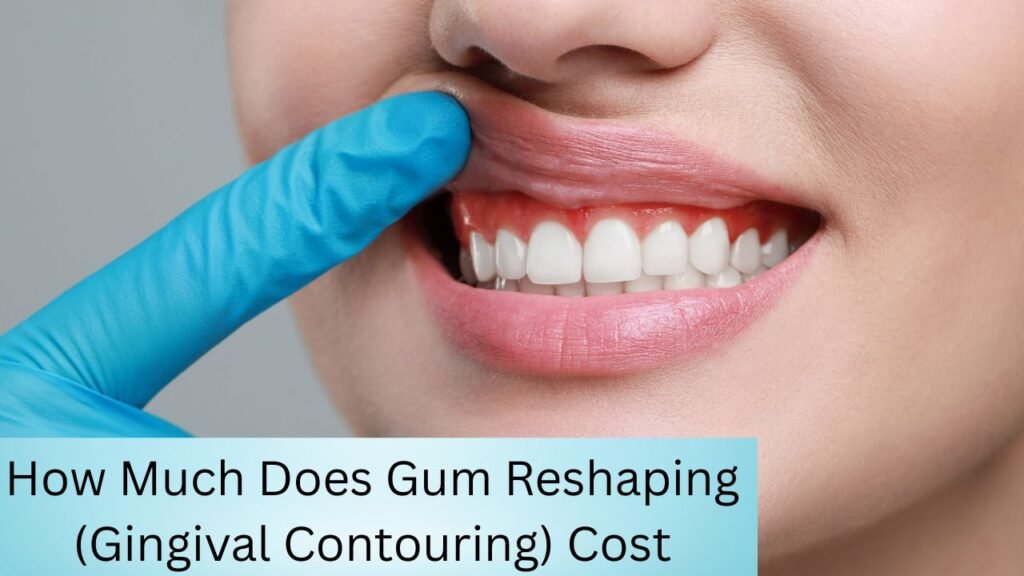How Much Does Gum Reshaping (Gingival Contouring) Cost?
When considering gum reshaping (gingival contouring), one of the first questions that comes to mind is: How much does it cost? Understanding the price range for this cosmetic procedure can be tricky, as there are several factors influencing the final cost. Typically, gum reshaping can range anywhere from $500 to $6000 depending on your needs and specific circumstances. This article will guide you through what influences these costs, helping you determine a realistic budget.
Quick Answer: How Much Does Gum Reshaping Cost?
- Minor Gum Reshaping (Single Area): $500 – $1500
- Full Upper Arch Reshaping: $3000 – $6000
- Laser Gum Reshaping: $1500 – $4000
- Cosmetic Reshaping (Front Teeth): $1000 – $3000
These costs typically reflect out-of-pocket expenses for cosmetic procedures since insurance coverage for these types of treatments is generally limited or nonexistent.

What Influences the Cost of Gum Contouring?
Gum reshaping costs can fluctuate due to various factors. Let’s break them down so you can better understand what to expect when planning for your procedure.
Extent of Treatment
The more extensive the reshaping, the higher the price. Minor reshaping on a small area of the gums can cost as low as $500 to $1500. However, if you need to reshape the entire upper arch, the cost can escalate to $3000 to $6000. This is one of the most significant cost factors, as the amount of work needed directly impacts both the time and resources used during the procedure.
Technology Used
The technology behind gum reshaping can also play a major role in the overall cost. Traditional gum reshaping methods using a scalpel tend to be more affordable, but laser gum reshaping, which uses advanced laser technology, tends to be pricier—ranging from $1500 to $4000. Lasers are often chosen because they offer benefits such as quicker healing, less bleeding, and more precision, which can justify the higher price tag for many patients.
Location and Expertise
Where you live and the expertise of the dentist can also influence how much you’ll pay for gum reshaping. For example, dentists in large cities or high-demand areas typically charge more due to increased overhead. Additionally, highly experienced or specialized cosmetic dentists often charge higher fees. This can range significantly depending on the geographical area—expect to pay more in metropolitan areas compared to rural locations.
Cosmetic vs. Medical Reasons for Gum Reshaping: Does It Affect Cost?
The reason behind your gum reshaping will significantly impact both the cost and the likelihood of insurance coverage. If you are undergoing gum reshaping for cosmetic reasons—for instance, to improve the appearance of your smile—you should expect to pay the full cost out-of-pocket.
On the other hand, if gum reshaping is required for medical reasons (e.g., to correct a gum condition causing functional problems), there might be some chance of insurance coverage, but this is rare. In general, cosmetic gum reshaping procedures are not covered by insurance, and patients will need to pay the full amount themselves.
Alternatives to Gum Contouring and Their Costs
If you’re considering alternatives to gum reshaping, you may want to know how their costs compare. Here’s a quick rundown:
- Veneers: If you want to correct the appearance of both teeth and gums, veneers might be an option. However, veneers are generally more expensive, typically ranging from $800 to $2500 per tooth.
- Gum Grafting: In cases of severe gum recession, you might need gum grafting instead of reshaping. This procedure typically costs $1000 to $3000, depending on the area treated.
Veneers may provide a more significant financial investment, as they not only address gum issues but also involve reshaping and covering the teeth themselves. Gum grafting may be needed if your gums have receded significantly, potentially resulting in higher costs than simple cosmetic reshaping.
Is Gum Reshaping Covered by Insurance?
Understanding insurance coverage is crucial for determining the final cost of your procedure. For purely cosmetic procedures, you can expect to pay out-of-pocket since insurance rarely covers these types of treatments. However, if the procedure is medically necessary, insurance may help cover part of the cost.
For example, if your gum issues are causing functional problems (such as difficulty chewing or speaking), some insurance plans might offer coverage. Check with your insurance provider to see if they cover any portion of the treatment, but be prepared for the possibility that you’ll pay the entire cost yourself for cosmetic cases.
Financing Options for Gum Reshaping
If the cost of gum reshaping feels like too much to handle upfront, consider financing options. Many dental offices offer payment plans or dental loans to help make the procedure more affordable. Here’s how to approach financing:
- Ask your dentist about payment plans, including interest rates and monthly payments. It’s crucial to understand the total repayment cost and how long you’ll be paying.
- Dental loans might be another option, allowing you to spread out payments over time.
When exploring financing, always calculate the total cost with interest to understand the full financial commitment. Be sure to also check if there are any hidden fees associated with financing options.
Conclusion: Get a Personalized Cost Estimate for Your Gum Reshaping Procedure
As we’ve explored, the cost of gum reshaping can vary greatly based on location, extent of treatment, technology used, and the reason for the procedure. To get an accurate price tailored to your situation, it’s essential to schedule a consultation with a dentist. During this consultation, your dentist can assess your needs and provide you with a precise cost estimate based on your specific requirements.
Ultimately, gum reshaping costs range from $500 to $6000, with various factors influencing this range. Keep in mind that for cosmetic procedures, you’ll likely be responsible for the full cost, while medical cases might offer some insurance coverage.